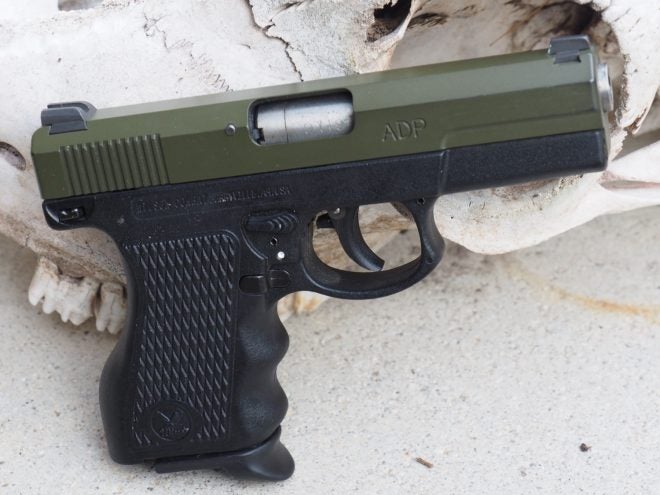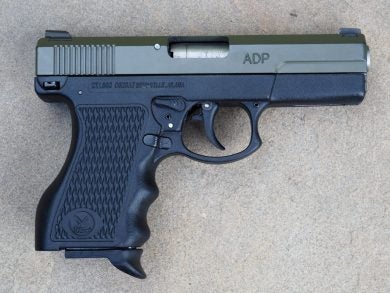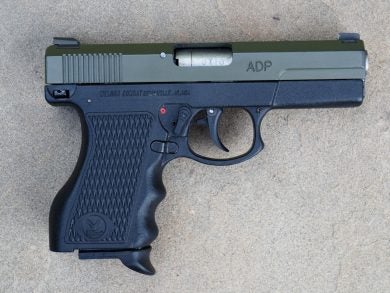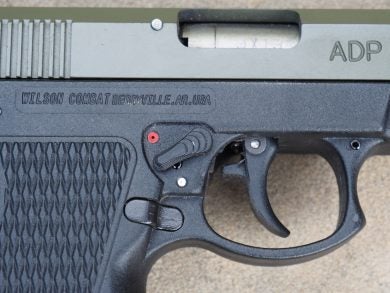My Experience With The Wilson Combat ADP
Up until Wilson Combat starting dabbling in Glocks and Beretta’s it was known as the bastion of all things John Moses Browning and .45ACP. There was, however, a little-known polymer frame 9mm already upgraded by Wilson: The ADP. Originally designed by Alex Du Plessis in the early 90’s for South African Arms company Aserma (of revolving shotgun fame), The ADP was a bit ahead of its time in being a slim, gas-delayed ultracompact 9mm pistol. Imagine if the Glock 43 had the gas delay of the HK P7 series. That is in essence the ADP. The concept itself is wonderful, but sadly like many other firearms, the execution was lacking. Quality control from Heritage Arms, the original US based importer of these pistols, was lacking enough to give the ADP a bad reputation amongst consumers of the ADP when it was branded as the “Heritage Stealth.” The most common complaint was reliability of the .40 caliber versions, as well as terrible materials and finishes.
In 2006, Wilson Combat contracted with Truvelo of South Africa to bring the improved Mark II version of the ADP into the US. With Wilson’s action tuning and highly durable finishes applied, the ADP received the improvements it needed in order to be a viable and reliable subcompact pistol that I carry and shoot quite frequently.
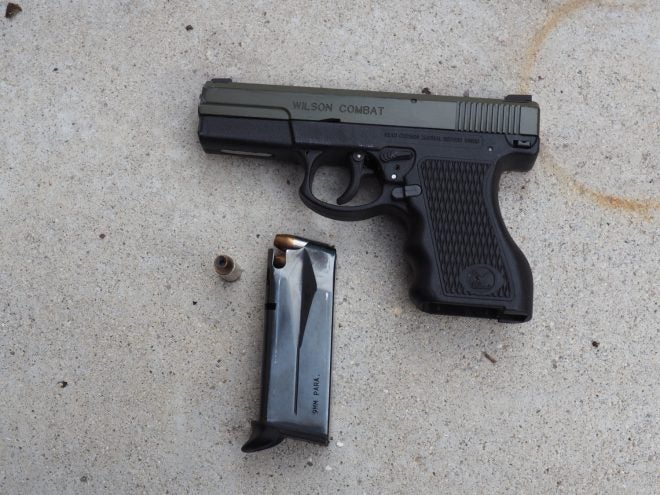
The ADP and its double stack, 10 round magazine
Specs:
- Weight: 19.5oz Unloaded
- Barrel Length: 3.75″
- Height: 4.2″
- Length: 6.3″
- Width: 1″
- Magazine Capacity: 10
- Sights: Fixed Two-Tone Tritium
- Striker-fired, gas delayed DAO
- Original MSRP: Approx. $650
Funky Breakdown:
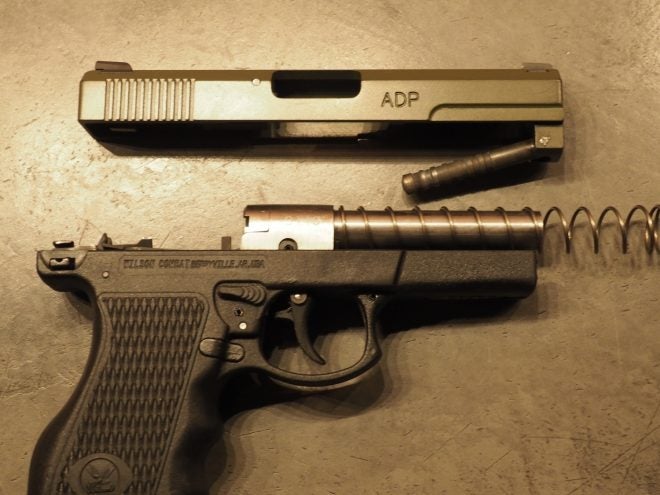
ADP broken down for cleaning. Note the gas piston attached to the slide
To break down the ADP for standard cleaning and maintenance, one must pinch two tabs on the rear of the frame. The rear of the slide is then able to lift up, and one can move the slide forward off the fixed barrel assembly. The recoil spring then can be removed from around the barrel. Reassembly of this pistol is what gets some people into trouble, and if done incorrectly, the slide will depart the frame upon firing. The recoil spring goes back over the barrel. Then the slide must be indexed with the barrel so that the gas piston can fit into the hole in the frame underneath the barrel. One then can move the slide rearward and downward until both tabs lock into the slide.
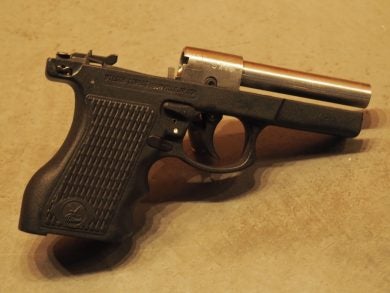
Barrel and frame assembly
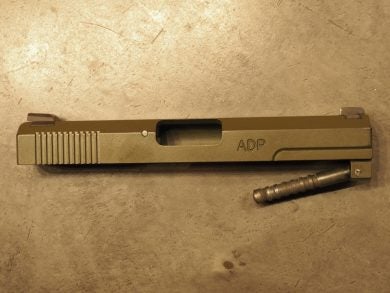
Slide and piston assembly
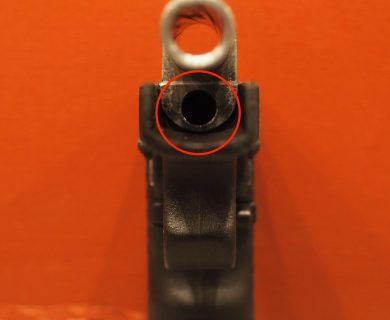
Gas piston must properly index with gas piston hole before completing reassembly
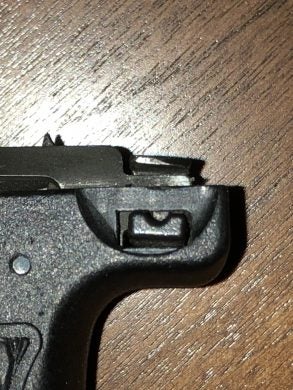
Disassembly tab at rear of frame
It is possible for the slide to be canted, and only one of the tabs to grab. Alternatively, if the spring that powers both tabs is very dirty, it can fail to lock the tabs into place. This is another way the slide can depart the frame. Overall, though one doesn’t have to pull the trigger, it is not the best or most foolproof of disassembly/reassembly procedures.
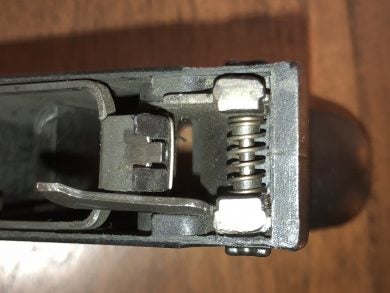
View of the spring and internal slide retention tabs that the disassembly tabs compress
Long-Term Experience:
I have carried and shot the ADP for quite some time now. After 1000’s of various rounds fired and 1000’s of hours carried, it has not malfunctioned once. Much like H&K’s P7 series, the frame above the trigger does get hot during extended practice sessions due the the gas piston. Despite this, I have never seen the frame warp or melt. I have been able to achieve reasonable accuracy for a gun of its size, much like one can expect with a G43 or M&P Shield.
Rough Spots:
The 6lb, 4oz trigger is smooth at first, but then exhibits stacking and has a break that I can best describe as “squishy”. The reset is also hard to feel. It’s best to let the trigger all the way out before firing again in a combat situation. This has a lot more to do with the overall design of the trigger rather than the ability of the master gunsmiths at Wilson Combat. There is no question that one can easily make modifications to achieve a far better trigger in the Shield or the subcompact Glocks. Not so with the ADP.
My main complaint with the ADP has been the safety. The safety lever of the ADP, while ambidextrous, is above and behind the trigger. It requires 90 degrees of movement, and does not lock positively enough in place for my liking. The safety requires sweeping off by either one’s firing hand thumb or trigger finger. I have elected to use my thumb. It has taken me many hours of practice in order to manipulate the safety swiftly every single time I have drawn the pistol. Sure, one could elect never to activate the safety. The problem is there is no way to know 100% for sure that the lever has not worked itself onto “safe” during the course of one’s day. If one does not at least check the lever position before firing, one risks a click instead of a boom.
- Safety on, denoted by the white dot on the frame behind the trigger
- Safety off, denoted by the red dot
- Safety lever in-between settings. this is why I always sweep the safety off during my drawstroke.
Positive Aspects:
Where Wilson’s expertise shines through is in the smoothness of the action, the reliability of the magazines, and the durability of the finish. The action is as smooth as one could wish a handgun action to be. It glides back and forth like it was made of two pieces of oiled glass and the slide racks with very little effort. The magazines have never failed to feed or function, and drop free every time. After 10 years of moderate use, my ADP’s green Armor-Tuff finish is just slightly wearing on a corner near the muzzle.
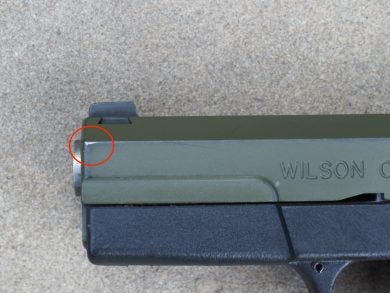
The one spot of slight wear, denoted by the red circle
The bore axis is very low, the recoil is very light even with higher pressure loads, and the fixed barrel gives more than acceptable accuracy out to 15 yards. I’m not a huge fan of the exposed striker, but I have experimented with firing this pistol in sub-zero temperatures, and it has not iced up or failed to fire. Though there is an imprecise fit between the striker and the hole in the rear of the slide, I have not found the hole to be an incursion point for lint or dirt of any kind.
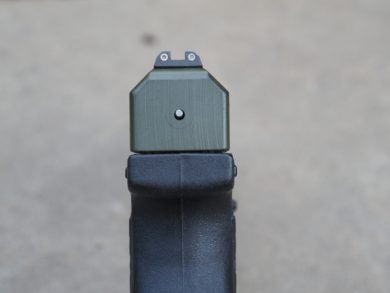
Exposed striker hole
Also of import is the ADP’s conceivability and suitability as a full-powered backup gun. The length, height, weight (the ADP is heavier by an ounce) and width of the ADP are nearly identical to the much more recent Glock 43, yet the barrel length and sight radius of the ADP are superior. My particular model came with a very nice leather IWB holster from Wilson, and the holster itself has held up incredibly well to a decade of use.

The holster has proved very durable.
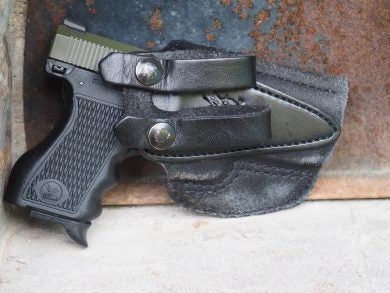
ADP in holster
Overall Impression:
The Wilson ADP seems to be the pinnacle of what the ADP series could achieve. Despite its quirks, I have found it to be a very reliable backup gun with a decent capacity. Serious fans of gas-delayed pistols like the P7 would be well served by adding one to their collection. I personally like my ADP plenty well enough and plan to keep using it. That being said, the rest of consumers who might want a similar backup or deep concealment gun in 9mm would be better served by more common choices out there from Ruger, SIG, S&W, or Glock.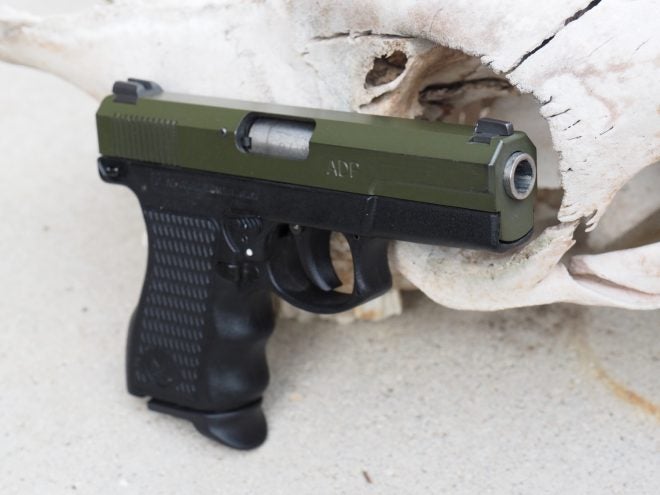
 Your Privacy Choices
Your Privacy Choices
